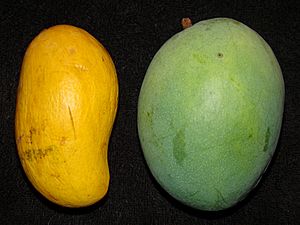Gold Nugget facts for kids
The Gold Nugget mango is a special kind of mango that first grew in south Florida. It's also sometimes called the Golden Nugget. People love this mango for its great taste and because the trees produce lots of fruit!
Quick facts for kids Mangifera 'Gold Nugget' |
|
|---|---|

Comparison of Ataulfo (left) and Gold Nugget (right)
|
|
| Genus | Mangifera |
| Species | Mangifera indica |
| Hybrid parentage | 'Kent' × unknown |
| Cultivar | 'Gold Nugget' |
| Origin | Florida, USA |
History of the Gold Nugget Mango
The very first Gold Nugget mango tree was grown by Edward F. Mitchell. He lived in Miami, Florida. Scientists once thought another mango called 'Saigon' might be its parent. However, a study in 2005 showed something different. It suggested that the Gold Nugget mango likely came from the 'Kent' mango.
Edward Mitchell received a special patent for the Gold Nugget mango. This happened in February 1990. A patent protects new inventions or plant types.
People quickly noticed how delicious this mango was. They also saw that the trees produced many fruits. Today, the Gold Nugget mango is grown in Florida. It's grown on a small scale for selling. You can also buy these trees from nurseries to plant in your own yard.
Some special places keep Gold Nugget trees in their collections. These include the USDA germplasm repository in Miami. The Miami-Dade Fruit and Spice Park in Homestead, Florida also has them. These places help protect different plant types.
What the Gold Nugget Mango Looks Like
The skin of the Gold Nugget mango changes color when it's ready to eat. It turns a bright yellow-orange. Sometimes, it might even have a little pink blush.
Inside, the fruit has yellow flesh. It's very smooth and doesn't have many fibers. The taste is mildly sweet and delicious. Each mango has one large seed inside.
Gold Nugget mangoes are usually oval-shaped. They weigh less than one pound. In Florida, these mangoes are typically ready to pick from late July to August.
The mango tree itself grows very strongly. It has an open shape, meaning its branches spread out.

